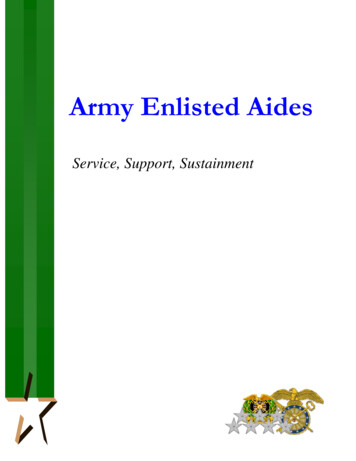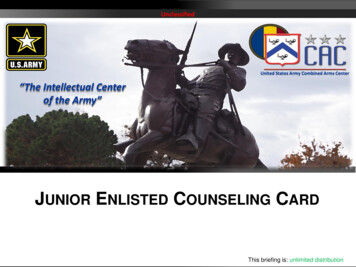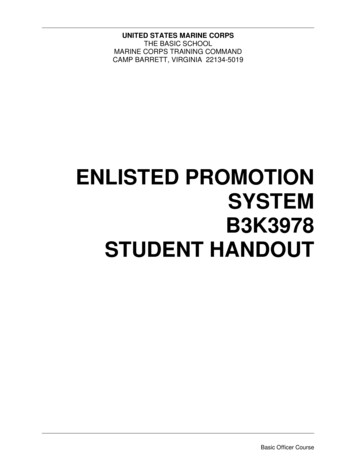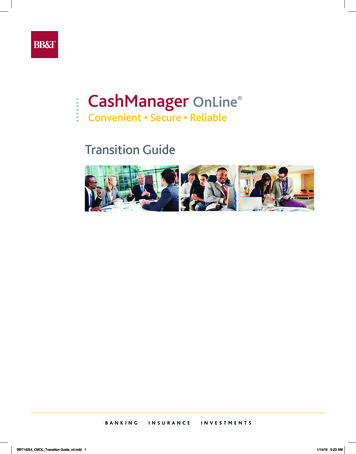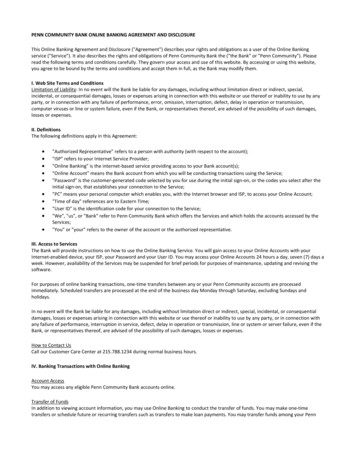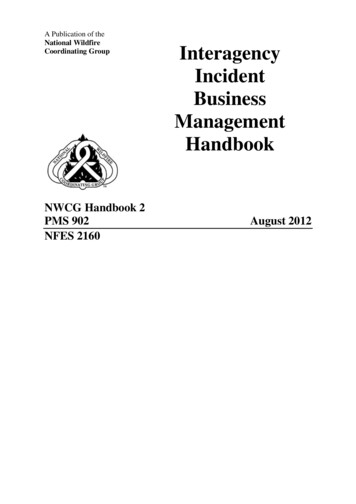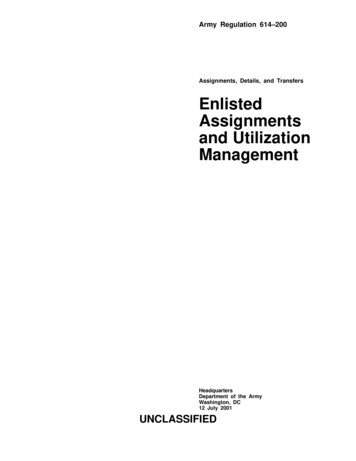
Transcription
Army Regulation 614–200Assignments, Details, and TransfersEnlistedAssignmentsand UtilizationManagementHeadquartersDepartment of the ArmyWashington, DC12 July 2001UNCLASSIFIED
Report Documentation PageReport Date12 Jul 2001Report TypeN/ADates Covered (from. to)-Title and SubtitleContract NumberAssignments, Details, and Transfers: Enlisted AssignmentsGrant Numberand Utilization ManagementProgram Element NumberAuthor(s)Project NumberTask NumberWork Unit NumberPerforming Organization Name(s) and Address(es)Department of the Army Headquarters Washington, DCPerforming Organization Report NumberSponsoring/Monitoring Agency Name(s) andAddress(es)Sponsor/Monitor’s Acronym(s)Sponsor/Monitor’s Report Number(s)Distribution/Availability StatementApproved for public release, distribution unlimitedSupplementary NotesAbstractSubject TermsReport ClassificationunclassifiedClassification of this pageunclassifiedClassification of AbstractunclassifiedLimitation of AbstractUUNumber of Pages101
SUMMARY of CHANGEAR 614–200Enlisted Assignments and Utilization ManagementThis revision-oAdds the Drill Sergeant Assignment Preference Program (DSAPP) and theDetailed Recruiter Assignment Preference Program (DRAPP) (para 3-3).oRequires mandatory utilization of school-trained additional skill identifier(ASI) assets for the minimum service-remaining requirement (para 3-13).oProvides that the Commandant, U.S. Army Element School of Music will award andwithdraw ASI “C1” (para 3-13).oProvides that commanders will select and train soldiers for valid battlestaff positions within 12 months of arrival at local duty station (para 3-13).oEstablishes a recertification process biennially for special duty assignmentpay (SDAP) (para 3-20).oAdds assignment eligibility and availability (AEA) code I (soldiers who haveapproved applications for warrant officer, Officer Candidate School and whoare awaiting class start date or Green to Gold Program) (table 3-1).oChanges the definition of AEA code “R” to read, “CONUS soldiers in thefollowing military occupational specialty (MOS): 75B, 75F, 75H, 71L and 74B,who have been awarded the PDSI for Standard Installation/Division PersonnelSystem (SIDPERS)-3 training. Termination date will not exceed 12 months”(table 3-1).oNotifies soldiers desiring to volunteer for special forces duty to contactthe Special Operations Recruiter Detachment (SORD), Ft Bragg, NC (para 5-5).oAllows voluntary applications for a new Army Career Program to be submittedafter completion of 24 months in career management field (CMF) 18 dutyassignments (para 5-5).oAdds permissive parachuting policy (para 5-6).oRescinds assignment instructions (AIs) issued prior to enrollment in theMarried Army Couples Program (MACP) remains firm (para 5-17).oAdds information on the Army Bands Career Program (para 6-6).
oProvides for the following changes as they affect the Sergeant Major of theArmy, command sergeants major, and sergeants major (chap 7):--a. Frocking: Soldiers must either be currently enrolled in the nonresidentsergeant major (SGM) course or be graduates of the SGM course.--b. Command Sergeants Major Board will select personnel to fill existing andprojected vacancies for a selected period consistent with Army needs.--c. Changes command sergeant major (CSM) nominative position policy.--d. Voluntary withdrawal from CSM Program--must have completed 24 months asa CSM at current continental United States (CONUS) station.oChanges primary MOS (PMOS) requirements for observer/controller positions atcombat training centers (para 8-8).oAdds selection criteria for motor transport operation (88M) at U.S. ArmyField Band (para 8-10).oAdds changes affecting drill sergeants (chap 8) including---a. Changes in selection criteria, including PERSCOM background screening.--b. Defining who has removal authority.
*Army Regulation 614–200HeadquartersDepartment of the ArmyWashington, DC12 July 2001Effective 13 August 2001Assignments, Details, and TransfersEnlisted Assignments and Utilization ManagementBy Order of the Secretary of the Army:ERIC K. SHINSEKIGeneral, United States ArmyChief of StaffOfficial:JOEL B. HUDSONAdministrative Assistant to theSecretary of the ArmyHistory. This printing publishes arevision of this publication.Summary. This regulation is a consolidation of regulations that cover the policyfor selection of enlisted soldiers for assignment, utilization, reclassification, details, transfers, and training, asimplemented by Department of DefenseDirective (DODD) 1315.7. Special dutyassignment pay (SDAP) is authorizedunder section 307, title 37, United StatesCode (37 USC 307). It is administered perContentsDODD 1304.21 and 1304.22 and DODInstruction (DODI) 7000–14.Applicability. This regulation applies toactive Army enlisted soldiers, excludinginitial entry training (IET) soldiers governed by AR 612–201. It also applies toArmy National Guard of the United States(ARNGUS), and U.S. Army Reserve(USAR) soldiers when on active duty(other than active duty for training), unless otherwise indicated. This regulation isnot required during mobilization, unlessotherwise indicated.Proponent and exception authority.The proponent of this regulation is theDeputy Chief of Staff for Personnel(DCSPER). The DCSPER has the authority to approve exceptions to this regulation that are consistent with controllinglaw and regulation. The DCSPER maydelegate the approval authority, in writing,to a division chief within the proponentagency in the grade of colonel or the civilian equivalent.Army management control process.This regulation contains management control provisions in accordance with AR11–2 and identifies key management controls that must be evaluated. A copy ofDA Form 11–2 is available on the ArmyElectronic Library CD-ROM and on theUSAPA web site.Supplementation. Supplementation ofthis regulation and establishment of command and local forms are prohibited without prior approval from Headquarters,Department of the Army (DAPE-MPE),300 Army Pentagon, Washington, DC20310–0300.Suggested Improvements. Users areinvited to send comments and suggestedimprovements on DA Form 2028 (Recommended Changes to Publications andBlank Forms) directly to Commander, U.S. Army Personnel Command (TAPCEPC-O), 2461 Eisenhower Ave,Alexandria, VA 22331.Distribution. This publication is available in electronic media only and is intended for command levels A, B, C, D,and E for Active Army and D and E forArmy National Guard of the United Statesand U.S. Army Reserve.(Listed by paragraph and page number)Chapter 1Introduction, page 1Section IGeneral, page 1Purpose 1–1, page 1References 1–2, page 1Explanation of abbreviations and terms 1–3, page 1Section IIAdministrative Assignment Policies, page 1Responsibilities 1–4, page 1Family Care Plan 1–5, page 1Exceptional Family Member Program 1–6, page 1*This publication supersedes AR 614–200, 31 October 1997.AR 614–200 12 July 2001UNCLASSIFIEDi
Contents—ContinuedLeave 1–7, page 1Security clearance 1–8, page 1Mode of travel 1–9, page 1Deletions and deferments 1–10, page 1Time-on-station 1–11, page 1Space Imbalanced Military Occupational Specialty (MOS) Program 1–12, page 1Chapter 2Responsibilities, page 2Section IDepartment of the Army Headquarters Level, page 2The Assistant Secretary of the Army for Manpower and Reserve Affairs 2–1, page 2The Deputy Chief of Staff for Personnel 2–2, page 2Section IIField Operating Agencies, page 2The Commanding General, U.S. Total Army Personnel Command 2–3, page 2The Commander, U.S. Army Central Personnel Security Clearance Facility 2–4, page 3The Commanding General, U.S. Army Training and Doctrine Command 2–5, page 3Section IIIOther Commands and Organizations, page 3Commanders of major Army commands 2–6, page 3The Commanding General, U.S. Army Recruiting Command 2–7, page 4Directors of personnel proponent schools and centers 2–8, page 4Commanders of hospitals having medical holding units 2–9, page 4Local activity and unit commanders 2–10, page 4Chiefs, Military Personnel Division/Personnel Service Battalion commanders 2–11, page 5Chapter 3Enlisted Assignment System, page 5Section IManaging Enlisted Assignments, page 5Overview 3–1, page 5Assignment selection criteria 3–2, page 5Assignment preferences 3–3, page 6Career management individual file 3–4, page 6Enlisted Distribution and Assignment System 3–5, page 7Enlisted distribution target model 3–6, page 7Requisitions 3–7, page 7Assignment eligibility and availability codes 3–8, page 8Section IIPersonnel Utilization, page 9Objectives 3–9, page 9Criteria 3–10, page 9Noncommissioned officer education system graduates 3–11, page 11Conscientious objectors 3–12, page 11Skill qualification identifiers, additional skill identifiers, and language codes (fifth through ninth characters of MOSC) 3–13, page 11Lateral appointments 3–14, page 12Immediately available soldiers 3–15, page 13iiAR 614–200 12 July 2001
Contents—ContinuedSection IIIPersonnel Classification/Reclassification, page 14Classification 3–16, page 14Scope of reclassification 3–17, page 14Reclassification of primary military occupational specialty/secondary military occupational specialty 3–18, page 14Regimental affiliation 3–19, page 15Section IVSpecial Duty Assignment/Foreign Language Proficiency Pay, page 15Scope 3–20, page 15Initiating special duty assignment pay 3–21, page 16Eligibility criteria for special duty assignment pay 3–22, page 16Method of payment 3–23, page 18Termination/reinstatement 3–24, page 18Chapter 4Attendance at Service Schools, page 18Applicability 4–1, page 18Application submission 4–2, page 18Selection criteria 4–3, page 18Waivers 4–4, page 19Administrative guidelines 4–5, page 20Service-remaining requirements 4–6, page 20School assignment and classification 4–7, page 22Dismissal from school 4–8, page 23Chapter 5Optional Assignments and Soldier Initiated Assignments or Actions, page 23Section IOptional Assignments, page 23Scope 5–1, page 23Objectives 5–2, page 23Airborne duty (special qualification identifier “P” (parachutist)) 5–3, page 24Ranger assignments (SQI “G” (ranger) and “V” (ranger parachutist)) 5–4, page 25Special Forces assignments (policy and selection criteria) 5–5, page 26The United States Army parachute team (The Golden Knights) 5–6, page 27Permissive parachuting policy 5–7, page 27Section IISoldier-Initiated Assignments, page 29Exchange assignments 5–8, page 29Assignment of sole surviving son or daughter 5–9, page 29Section IIICompassionate Actions, page 30Overview 5–10, page 30Criteria 5–11, page 31Supporting documentation 5–12, page 31Compassionate requests when problems are temporary 5–13, page 34Compassionate requests when problems are not expected to be resolved within one year 5–14, page 34Compassionate reassignments under emergency conditions 5–15, page 34Section IVMarried Army Couples Program, page 35Applicability 5–16, page 35AR 614–200 12 July 2001iii
Contents—ContinuedScope 5–17, page 35Criteria 5–18, page 36Soldiers in advanced individual training 5–19, page 37Permissive assignments 5–20, page 37Disenrollment from MACP 5–21, page 37Chapter 6Career Development Programs and Instructor/Adviser Positions, page 38Section ICareer Development Programs, page 38Overview 6–1, page 38Objectives 6–2, page 38The Intelligence Career Program 6–3, page 38The Explosive Ordnance Disposal Career Program 6–4, page 39The Technical Escort Training Program 6–5, page 40The Army Bands Career Program 6–6, page 40Section IIEnlisted Instructor or Adviser Positions, page 42Scope 6–7, page 42Objectives 6–8, page 43Selection criteria 6–9, page 43Project warriors at combat training centers 6–10, page 43Active Component to Reserve Component full-time manning advisers and reserve officers training corps instructors 6–11, page 44Uniformed service school instructors 6–12, page 44Sergeants Major Academy instructors 6–13, page 44Chapter 7Sergeant Major of the Army, Command Sergeants Major, and Sergeants Major, page 45Section IOverview, page 45Scope 7–1, page 45Centralized management 7–2, page 45Sergeant Major of the Army 7–3, page 45Frocking 7–4, page 45Section IICommand Sergeant Major Management, page 48Designation of command sergeant major positions 7–5, page 48Selection of command sergeant major 7–6, page 48Appointment to command sergeant major 7–7, page 49Certificate of Appointment to Command Sergeant Major 7–8, page 49Assignment and utilization 7–9, page 50Release from Command Sergeant Major Program or removal of command sergeant major(D) from recommended list 7–10, page 51Section IIISergeant Major Management, page 52Overview 7–11, page 52Assignment and utilization 7–12, page 52Nominative assignments 7–13, page 52ivAR 614–200 12 July 2001
Contents—ContinuedSection IVCommand Sergeant Major and Sergeant Major Position Tracking, page 52Overview 7–14, page 52Reporting requirements 7–15, page 52Interim reports 7–16, page 53Chapter 8Assignment to Specific Type Organizations/Activities or Duty Positions, page 53Section IPresidential Support Activities, page 53Scope 8–1, page 53Qualification criteria 8–2, page 54Investigative requirements 8–3, page 54Assignment termination 8–4, page 55White House Communications Agency 8–5, page 55White House Transportation Agency 8–6, page 55First Battalion 3rd U.S. Infantry (The Old Guard) and attached units assignments 8–7, page 55Section IISpecific Type Duty Positions, page 56Observer/controller at combat training centers 8–8, page 56U.S. Military Entrance Processing Command assignments 8–9, page 56Motor Transport Operator (88M) at United States Army Field Band 8–10, page 57Broadcast journalist (46R) at Soldiers Radio & Television 8–11, page 57Enlisted aides on the personal staff of general officers 8–12, page 57Inspector general positions 8–13, page 58Section IIIDrill Sergeant Program, page 58Scope 8–14, page 58Drill sergeant candidate prerequisites 8–15, page 59Qualification criteria 8–16, page 60Drill sergeant tour of duty 8–17, page 60Removal from the Drill Sergeant Program 8–18, page 61Section IVFirst Sergeant Positions, page 62Scope 8–19, page 62Eligibility 8–20, page 62Criteria 8–21, page 63Awarding skill qualification identifier “M” 8–22, page 63Required training 8–23, page 63Lateral appointments to first sergeant 8–24, page 64Frocking of sergeant first class (P) to first sergeant 8–25, page 64Withdrawal of skill qualification identifier “M” 8–26, page 64Recruiting duty 8–27, page 64Equal opportunity advisor 8–28, page 65United States Army Criminal Investigation Command (CID) 8–29, page 65Army Linguist Program 8–30, page 65Chapter 9Miscellaneous-type assignments, page 66Section IHomebase and Advance Assignment Program, page 66AR 614–200 12 July 2001v
Contents—ContinuedScope 9–1, page 66Criteria 9–2, page 66Section IIAssignment of Choice for MACOM NCO of the Year, page 66Objective 9–3, page 66Criteria 9–4, page 66Section IIISpecial Assignments, page 67Scope 9–5, page 67General selection criteria 9–6, page 67Waivers 9–7, page 67International and OCONUS joint headquarters U.S. military missions, MAAGs, JUSMAGs, and similar activities 9–8, page 67U.S. Central Command 9–9, page 68U.S. Army Intelligence and Security Command 9–10, page 68Defense Courier Service 9–11, page 68U.S. Transportation Command 9–12, page 68U.S. Allied Command Europe 9–13, page 68U.S. Military Academy, U.S. Army Command and General Staff College, and U.S. Army War College 9–14,page 68Section IVNominative Assignments, page 69Scope 9–15, page 69Overview 9–16, page 69Selection criteria 9–17, page 69AppendixesA.References, page 70B.Email Addresses, page 73C.Management Control Evaluation Checklist, page 73Table �1:4–2:Determining AEA codes, page 8Determining IA Codes, page 13SDAP scale, page 17Service Obligation For Training, page 21School Application Approval Authority, page 22Figure SampleSampleSampleSampleSampleStatement of Understanding for an Exchange Assignment, page 29of a Completed DA Form 3739, page 32of a Completed DA Form 3739–Continued, page 33of Suggested Frocking Format, page 46of a Completed DA Form, page 47of an Acceptance Statement for CSM Consideration, page 49of Declination Statement for CSM Consideration, page 49GlossaryIndexviAR 614–200 12 July 2001
Chapter 1IntroductionSection IGeneral1–1. PurposeThis regulation prescribes the reporting, selection, assignment, and utilization of Active Army enlisted personnel,excluding initial entry training (IET) soldiers who are governed by Army Regulation (AR) 612–201. It provides generalassignment policies and responsibilities for managing the enlisted force. Guidance in this regulation is in addition tothat in AR 614–5 and 614–30.1–2. Referencesa. Required and related publications and prescribed and referenced forms are listed in appendix A.b. Applicable email addresses are listed in appendix B.1–3. Explanation of abbreviations and termsAbbreviations and special terms used in this regulation are explained in the glossary.Section IIAdministrative Assignment Policies1–4. ResponsibilitiesResponsibilities are listed in chapter 2.1–5. Family Care PlanTo ensure that all soldiers (regardless of grade) can deploy promptly and perform their military duties when notdeployed, family care plans (FCPs) to cover dependent family members must be in place. The FCP is governed by AR600–20.1–6. Exceptional Family Member ProgramThe Exceptional Family Member Program (EFMP) allows U.S. Total Army Personnel Command (PERSCOM) toconsider the special education and medical needs of exceptional family members during the assignment process andreassign soldiers, when readiness does not require a specific reassignment, to an area where the needs can beaccommodated. The EFMP is governed by AR 608–75.1–7. LeaveLeave may be granted to each soldier, upon request, at the discretion of the soldier’s immediate commander if it doesnot interfere with the soldier’s port call or reporting date. Leave policy is governed by AR 600–8–10.1–8. Security clearanceAssignment instructions (AIs) from PERSCOM will include personnel security requirements. AR 600–8–11 providesprocedures for processing AIs requiring security clearance. Soldiers will not be held at the home station pending resultsof the investigation unless such guidance is in the assignment instruction.1–9. Mode of travelAir transportation is the chief mode of travel for soldiers to and from assignment areas. (For exceptions, see AR55–46.)1–10. Deletions and defermentsDeletions and deferments are governed by AR 600–8–11.1–11. Time-on-stationTime-on-station (TOS) applies only to continental United States (CONUS)-based soldiers; outside continental UnitedStates (OCONUS)-based soldiers have designated tour lengths. No maximum TOS is used in U.S. Army assignmentprocedures. When possible, soldiers will remain on station for the maximum number of years possible consistent withArmy requirements.1–12. Space Imbalanced Military Occupational Specialty (MOS) Programa. A space imbalanced MOS (SIMOS) condition exists when 55 percent of the authorizations are OCONUS. ThisAR 614–200 12 July 20011
program is intended for grades sergeant (SGT) through sergeant first class (SFC) and is designed to enhance personnelretention in the career force and to provide more effective use of enlisted soldiers.b. Participation in the program by soldiers holding a SIMOS is mandatory and will be closely monitored withprimary emphasis on improving readiness of OCONUS units requiring soldiers’ skills, equity of OCONUS assignment,and CONUS turnaround time.c. Soldiers with a secondary MOS (SMOS) that is SIMOS will also be considered for inclusion in the SIMOSProgram. Consideration will be given to the status of current primary military occupational specialty (PMOS) andcareer progression MOS (CPMOS), need and availability of refresher training in SMOS upon deployment OCONUS,and PMOS/CPMOS upon return to CONUS and availability of soldiers holding the SIMOS as PMOS.Chapter 2ResponsibilitiesSection IDepartment of the Army Headquarters Level2–1. The Assistant Secretary of the Army for Manpower and Reserve AffairsThe Assistant Secretary of the Army for Manpower and Reserve Affairs (ASA(M&RA)) will—a. Oversee assignment policy.b. Approve second permanent change of station (PCS) assignments within the same fiscal year.2–2. The Deputy Chief of Staff for PersonnelThe Deputy Chief of Staff for Personnel (DCSPER) will—a. Develop assignment policy for enlisted personnel.b. Designate all command sergeant major (CSM) positions.c. Establish policy for the SIMOS Program.d. Grant exceptions on a case-by-case basis to nonstatutory provisions of this regulation, unless otherwise restricted.Section IIField Operating Agencies2–3. The Commanding General, U.S. Total Army Personnel CommandThe Commanding General, U.S. Total Army Personnel Command (CG, PERSCOM) will—a. Interpret and implement policies initiated by DCSPER.b. Issue AIs.c. Manage the distribution of soldiers to support the Army’s mission worldwide.d. Manage the CSM Program.e. Implement assignment and utilization policies and monitor sergeant major (SGM) assignments throughout theArmy.f. Provide all soldiers with broad opportunities for career progression and development, including approving applications for training.g. Supervise all personnel management functions for SIMOS, including identifying MOSs that are space imbalancedand publishing a SIMOS listing at least once a year.h. Make final decision on all joint domicile (JD) assignments.i. Administer and monitor the Special Duty Assignment Pay (SDAP) Program.j. Establish and maintain procedures in support of the Detailed Recruiter Assignment Preference Program (DRAPP)and Drill Sergeant Assignment Preference Program (DSAPP).k. Establish procedures for managing, developing, and assigning soldiers in career development programs (Intelligence Career Program, Explosive Ordnance Disposal (EOD) Career Program, Army Band Career Program (ABCP),and technical escort (TE) training).l. Approve Bonus Extension and Retraining (BEAR) Program and Special Forces (SF) reenlistment option applications for training and assignment to SF units, including—(1) Approving voluntary reclassification applications for training and assignment to SF units.(2) Coordinating with Commander, U.S. Army John F. Kennedy Special Warfare Center and School(USAJFKSWC) (ATTN: AOJK–SP), Fort Bragg, NC 28307–5000, on those applications that require a waiver.m. When necessary, delegate approval authority to CDR, USAJFKSWC to—(1) Approve waivers for BEAR and SF reenlistment option applications.2AR 614–200 12 July 2001
(2) Approve all voluntary applications including waivers (when needed), for SF training and reclassification intocareer management field (CMF 18).(3) Award appropriate CMF MOS to Active Army (AA) soldiers who have completed SF qualification course(SFQC).(4) Report soldiers who fail to successfully complete the SFQC training to PERSCOM (TAPC-EPK-S).n. Manage the Drill Sergeant (DS) Program. The CG, PERSCOM has centralized control over the selection,assignment, classification, and release of all AA soldiers assigned to the DS program. The DS Assignment Team(TAPC-EPK-ID), Infantry Branch, Combat Arms Division, is the PERSCOM point of contact for personnel mattersconcerning all active duty (AD) soldiers in the program. This includes requests to enter, requests for deletion/defermentfrom the DS Program, requests for third-year DS extensions, and soldier appeals to Drill Sergeant Program removalactions.o. Develop procedures and programs to implement DA policy pertaining to reclassification, includingreclassifications—(1) For staff sergeant (promotable) (SSG(P)) and above, regardless of MOS.(2) Requiring recoupment of bonus.(3) Resulting from change to the MOS structure reflected in DA PAM 611–21.p. Grant exceptions on a case-by-case basis to nonstatutory provisions of this regulation, unless otherwise restricted.This authority may be delegated to an authorized official in the grade of brigadier general (BG) or equivalent civiliangrade level who directs assignment policies or procedures for the Army. This authority will not be delegated tocommands.q. Develop procedures to implement the policies established herein.2–4. The Commander, U.S. Army Central Personnel Security Clearance FacilityThe Commander, U.S. Army Central Personnel Security Clearance Facility (CDR, CCF), will—a. Review criminal and investigative dossiers.b. Evaluate and make Army military security clearance eligibility determinations.2–5. The Commanding General, U.S. Army Training and Doctrine CommandThe Commanding General, U.S. Army Training and Doctrine Command (CG, TRADOC), will—a. Publicize career development programs, and—(1) Counsel prospective soldiers on program opportunities and requirements.(2) Ensure applicants are eligible before applying for membership or training.b. Develop initial and transition training to support the SIMOS Program.c. Review modification table of organization and equipment/table of distribution and allowances (MTOE/TDA) forSIMOS positions to maximize CONUS documentation and ensure proper utilization and assignment of soldiers.d. Manage the DS Program by—(1) Operating the DS school.(2) Removing soldiers from school (when reason warrants) and returning them to their home station.(3) Completing academic evaluation reports.(4) Providing strength management statistics.(5) Providing vital information on all soldiers who report to, as well as who graduate from, DS school.(6) Providing historical data, including removal data, on soldiers who have served DS duty.(7) Publicizing the DSAPP.e. Approve reclassification of soldiers in grade of SSG (nonpromotable) (SSG (non-P)), and below, when their MOSis authorized by the PERSCOM reenlistment/reclassification IN/OUT call message or otherwise directed byPERSCOM. (Responsibilities in this paragraph are further delegated to commanders of TRADOC installations.)Section IIIOther Commands and Organizations2–6. Commanders of major Army commandsCommanders of major Army commands (MACOMs) will be responsible for the following personnel matters thatpertain to their command or to agencies under their jurisdiction. Responsibilities in this paragraph are further delegatedto commanders of U.S. Army Forces Command (FORSCOM) installations. FORSCOM will monitor and assist toensure compliance with policies established by this regulation. Commanders will—a. Submit enlisted personnel requisitions to PERSCOM reflecting personnel requirements.b. Ensure that soldiers within their commands are properly assigned and utilized.c. Approve reclassification of soldiers, SSG (non-P) and below, when their MOS is authorized by the PERSCOM’sreenlistment/reclassification IN/OUT call message, or otherwise directed by PERSCOM.AR 614–200 12 July 20013
d. Ensure soldiers are afforded an opportunity for training and that—(1) Their applications are processed promptly.(2) When selected, they are fully qualified.e. Manage DS Program, if applicable, including providing PERSCOM a central point of contact.f. Administer, monitor, and supervise the SDAP Program for all soldiers who receive SDAP within their respectivecommands. (See also appendix C regarding the management control process for SDAP.)g. Publicize the career development programs and—(1) Counsel prospective soldiers on program opportunities and requirements.(2) Ensure applicants are eligible for membership or training.h. Approve or disapprove exchange assignments.i. Authorize any commander with general court-martial (GCM) convening authority to prescribe assignment limitations for sole surviving sons or daughters.j. Publicize the Special Forces (SF) Program.k. Delegate to subordinate installation commanders authority to assign soldiers, including determining soldiers’suitability for assignments from a security standpoint. Commanders should consult with appropriate installation securityofficials to ensure soldiers meet the security requirements of projected assignment.2–7. The Commanding General, U.S. Army Recruiting CommandThe Commanding General, U.S. Army Recruiting Command (CG, USAREC) will—a. Be responsible for the SF Recruiting Program.b. Award appropriate CMF 18 MOS to Reserve Component soldiers who elect to qualify by attending residentinstruction.c. Publicize the DRAPP.2–8. Directors of personnel proponent schools and centersDirectors will—a. Grant waivers of qualifications specified in DA PAM 351–4, as appropriate.b. Evaluate ways to reduce or eliminate SIMOS (both current or projected) through changes to MTOE/TDA, MOSmergers or conversions, or, in the case of new fielding, modification of the fielding schedule.c. Identify non-SIMOS TDA positions within the personnel proponents’ affected CMF to be recoded as SIMOS. Ifno CMF position can be identified as SIMOS, the director will coordinate with PERSCOM (TAPC-PLI) and providejustification to identify other TDA positions for the affected SIMOS.d. Recommend changes in service-remaining requirements for those MOS that are deemed critically short, therebyenhancing the return on the training investment and the maximum retainability of soldiers in shortage skills.e. Manage DS Program by operating the DS school, and, as appropriate, remove soldiers from school and returnthem to their home station.2–9. Commanders of hospitals having medical holding unitsCommanders—a. May reassign patients to, from, or between medical holding detachments without consulting the MACOMcommander.b. Must notify gaining or losing installation’s strength management s
The Commander, U.S. Army Central Personnel Security Clearance Facility 2-4, page 3 The Commanding General, U.S. Army Training and Doctrine Command 2-5, page 3 Section III Other Commands and Organizations, page 3 Commanders of major Army commands 2-6, page 3 The Commanding General, U.S. Army Recruiting Command 2-7, page 4
